A Novel Characteristic Gastric Mucus Named “Web-like Mucus” Potentially Induced by Vonoprazan
Abstract
1. Introduction
2. Methods
2.1. Definitions of Web-like Mucus
2.2. Patients
2.3. Endoscopic Procedure and Diagnosis
2.4. Statistical Analysis
3. Results
3.1. Patients Characteristics
3.2. Endoscopic Findings and Clinicopathological Evaluation
4. Discussion
5. Conclusions
Supplementary Materials
Author Contributions
Funding
Institutional Review Board Statement
Informed Consent Statement
Data Availability Statement
Acknowledgments
Conflicts of Interest
References
- Arikawa, Y.; Nishida, H.; Kurasawa, O.; Hasuoka, A.; Hirase, K.; Inatomi, N.; Hori, Y.; Matsukawa, J.; Imanishi, A.; Kondo, M.; et al. Discovery of a novel pyrrole derivative 1-[5-(2-fluorophenyl)-1-(pyridin-3-ylsulfonyl)-1H-pyrrol-3-yl]-N-methylmethanamine fumarate (TAK-438) as a potassium-competitive acid blocker (P-CAB). J. Med. Chem. 2012, 55, 4446–4456. [Google Scholar] [CrossRef] [PubMed]
- Parsons, M.E.; Keeling, D.J. Novel approaches to the pharmacological blockade of gastric acid secretion. Expert Opin. Investig. Drugs 2005, 14, 411–421. [Google Scholar] [CrossRef] [PubMed]
- Ashida, K.; Sakurai, Y.; Hori, T.; Kudou, K.; Nishimura, A.; Hiramatsu, N.; Umegaki, R.; Iwakiri, K. Randomised clinical trial: A dose-ranging study of vonoprazan, a novel potassium-competitive acid blocker, vs. lansoprazole for the healing of erosive oesophagitis. Aliment. Pharmacol. Ther. 2016, 43, 240–251. [Google Scholar] [CrossRef] [PubMed]
- Jung, Y.S.; Kim, E.H.; Park, C.H. Systematic review with meta-analysis: The efficacy of vonoprazan-based trial therapy on Helicobactor pylori eradication. Aliment. Pharmacol. Ther. 2017, 46, 106–114. [Google Scholar] [CrossRef] [PubMed]
- Tsuchiya, I.; Kato, Y.; Tanida, E.; Masui, Y.; Kato, S.; Nakajima, A.; Izumi, M. Effect of vonoprazan on the treatment of artificial gastric ulcers after endoscopic submucosal dissection: Prospective randomized controlled trial. Dig. Endosc. 2017, 29, 576–583. [Google Scholar] [CrossRef] [PubMed]
- Kawai, T.; Oda, K.; Funao, N.; Nishimura, A.; Soen, S.; Kawai, T.; Ashida, K.; Sugano, K. Vonoprazan prevents low-dose aspirin-associated ulcer recurrence: Randomised phase 3 study. Gut 2018, 67, 1033–1041. [Google Scholar] [CrossRef] [PubMed]
- Mizokami, Y.; Oda, K.; Funao, N.; Nishimura, A.; Soen, S.; Kawai, T.; Ashida, K.; Sugano, K. Vonoprazan prevents ulcer recurrence during long-term NSAID therapy: Randomised, lansoprazole controlled non-inferiority and single-blind extension study. Gut 2018, 67, 1042–1051. [Google Scholar] [CrossRef] [PubMed]
- Miyamoto, S.; Matsuno, Y.; Kato, M.; Kudo, T.; Ono, S.; Shimizu, Y.; Sakamoto, N. Parietal cell protrusions and dilated oxyntic glands from use of vonoprazan. Am. J. Gastroenterol. 2017, 112, 1899–1901. [Google Scholar] [CrossRef]
- Miwa, W.; Hiratsuka, T.; Sato, K.; Fujino, T.; Kato, Y. Development of white globe appearance lesions in the noncancerous stomach after vonoprazan administration: A report of two cases with a literature review. Clin. J. Gastroenterol. 2021, 14, 48–58. [Google Scholar] [CrossRef]
- Kubo, K.; Kimura, N.; Watanabe, R.; Higashino, M.; Tsuda, M.; Kato, M. Vonoprazan-associated gastric mucosal redness in non-Helicobacter pylori-infected and Helicobacter pylori-eradicated stomach. Case Rep. Gastroenterol. 2021, 15, 751–758. [Google Scholar] [CrossRef]
- Yoshizaki, T.; Morisawa, T.; Fujinami, M.; Matsuda, T.; Katayama, N.; Inoue, K.; Matsumoto, M.; Ikeoka, S.; Takagi, M.; Sako, T.; et al. Propensity score matching analysis: Incidence and risk factors for “stardust” gastric mucosa, a novel gastric finding potentially induced by vonoprazan. Aliment. Pharmacol. Ther. 2021, 53, 94–102. [Google Scholar] [CrossRef] [PubMed]
- Terao, S.; Susuki, S.; Yaita, H.; Kurahara, K.; Shunto, J.; Furuta, T.; Maruyama, Y.; Ito, M.; Kameda, T.; Aoki, R.; et al. Multicenter study of autoimmune gastritis in Japan: Clinical and endoscopic characteristics. Dig. Endosc. 2020, 32, 364–372. [Google Scholar] [CrossRef] [PubMed]
- Kimura, K.; Takemoto, T. An endoscopic recognition of the atrophic border and its significance in chronic gastritis. Endoscopy 2008, 1, 87–97. [Google Scholar] [CrossRef]
- Martin, F.C.; Chenevix-Trench, G.; Yeomans, N.D. Systemic review with meta-analysis: Fundic gland polyps and proton pump inhibitors. Aliment. Pharmacol. Ther. 2016, 44, 915–925. [Google Scholar] [CrossRef]
- Kim, G.H. Proton pump inhibitor-related gastric mucosal changes. Gut Liver 2021, 15, 646–652. [Google Scholar] [CrossRef] [PubMed]
- Hori, Y.; Matsukawa, J.; Takeuchi, T.; Nishida, H.; Kajino, M.; Inatomi, N. A study comparing the antisecretory effect of TAK-438, a novel potassium-competitive acid blocker, with lansoprazole in animals. J. Pharmacol. Exp. Ther. 2011, 337, 797–804. [Google Scholar] [CrossRef] [PubMed]
- Yandrapu, H.; Sarosiek, J. Protective factors of the gastric and duodenal mucosa: An overview. Curr. Gastroenterol. Rep. 2015, 17, 24. [Google Scholar] [CrossRef]
- Allen, A.; Flemström, G. Gastroduodenal mucus bicarbonate barrier: Protection against acid and pepsin. Am. J. Physiol. Cell Physiol. 2005, 288, C1–C19. [Google Scholar] [CrossRef] [PubMed]
- Gindzienski, A.; Zwierz, K.; Sarosiek, J. The role of mucus and its components in protection and repair within the alimentary tract mucosa: Polish experience. J. Physiol. Pharmacol. 2003, 54 (Suppl. S3), 127–144. [Google Scholar]
- Laine, L.; Takeuchi, K.; Tarnawsli, A. Gastric mucosal defence and cytoprotection: Bench to bedside. Gastroenterology 2008, 135, 41–60. [Google Scholar] [CrossRef]
- Thim, L.; Madsen, F.; Poulsen, S.S. Effect of trefoil factors on the viscoelastic properties of mucus gels. Eur. J. Clin. Investig. 2022, 32, 519–527. [Google Scholar] [CrossRef] [PubMed]
- Del Piano, M.; Pagliarulo, M.; Tari, R.; Carmagnola, S.; Balzarini, M.; Lorenzini, P.; Pane, M. Correlation between chronic treatment with proton pump inhibitors and bacterial overgrowth in the stomach: Any possible beneficial role for selected lactobacilli? J. Clin. Gastroenterol. 2014, 48 (Suppl. S1), S40–S46. [Google Scholar] [CrossRef] [PubMed]
- Sanduleanu, S.; Jonkers, D.; De Bruine, A.; Hameeteman, W.; Stockbrügger, R.W. Non-Helicobacter pylori bacterial flora during acid-suppressive therapy: Differential findings in gastric juice and gastric mucosa. Aliment. Pharmacol. Ther. 2001, 15, 379–388. [Google Scholar] [CrossRef] [PubMed]
- Minalyan, A.; Gabrielyan, L.; Scott, D.; Jacobs, J.; Pisegna, J.R. The gastric and intestinal microbiome: Role of proton pump inhibitors. Curr. Gastroenterol. Rep. 2017, 19, 42. [Google Scholar] [CrossRef] [PubMed]
- Abranches, J.; Zeng, L.; Kajfasz, J.K.; Palmer, S.R.; Chakraborty, B.; Wen, Z.T.; Richards, V.P.; Brady, L.J.; Lemos, J.A. Biology of oral streptococci. Microbiol. Spectr. 2018, 6. [Google Scholar] [CrossRef]
- Matsukawa, J.; Kogame, A.; Tagawa, Y.; Inatomi, N. Radiographic localization study of a novel potassium-competitive acid blocker, vonoprazan, in the rat gastric mucosa. Dig. Dis. Sci. 2016, 61, 1888–1894. [Google Scholar] [CrossRef]
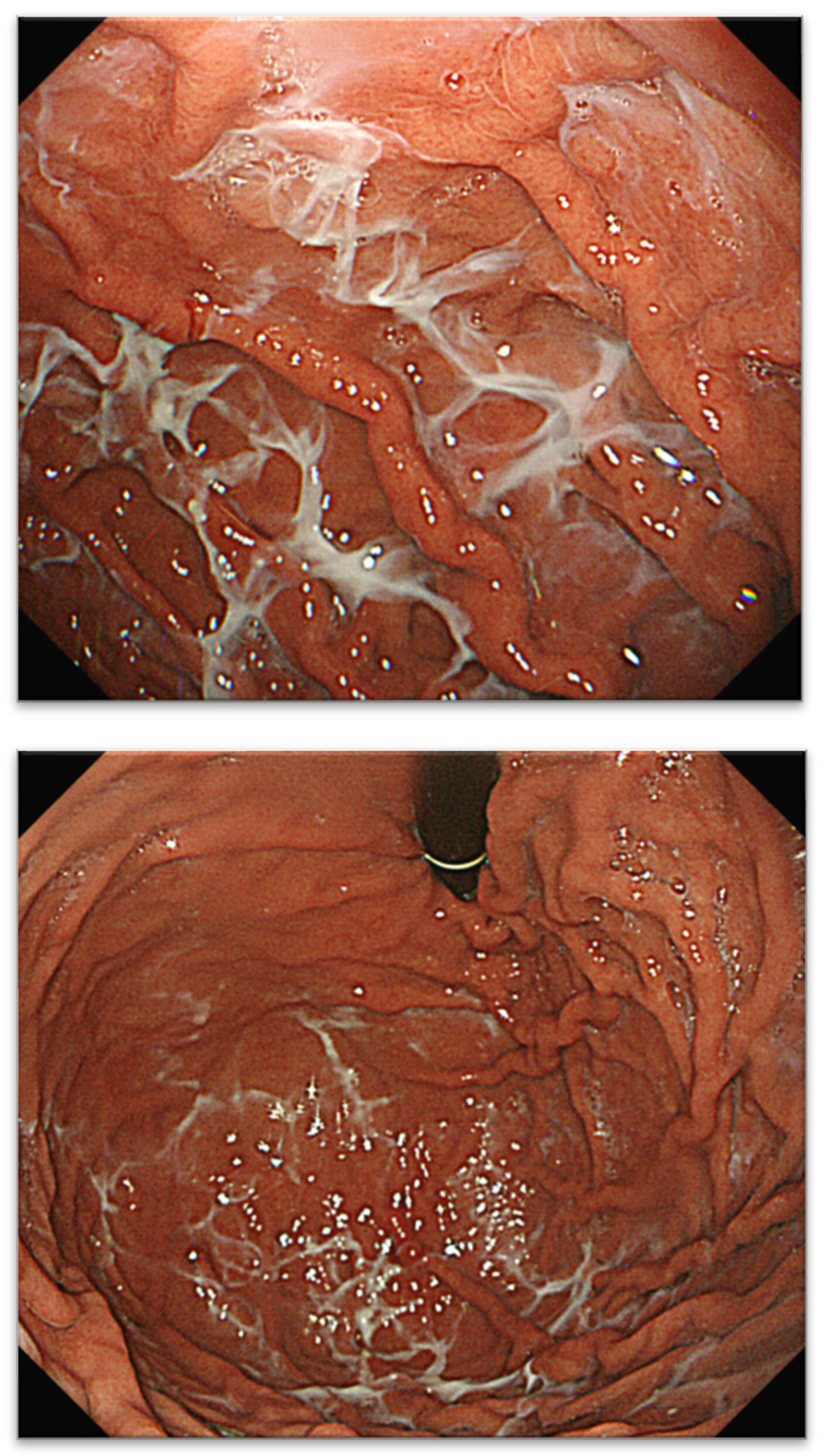
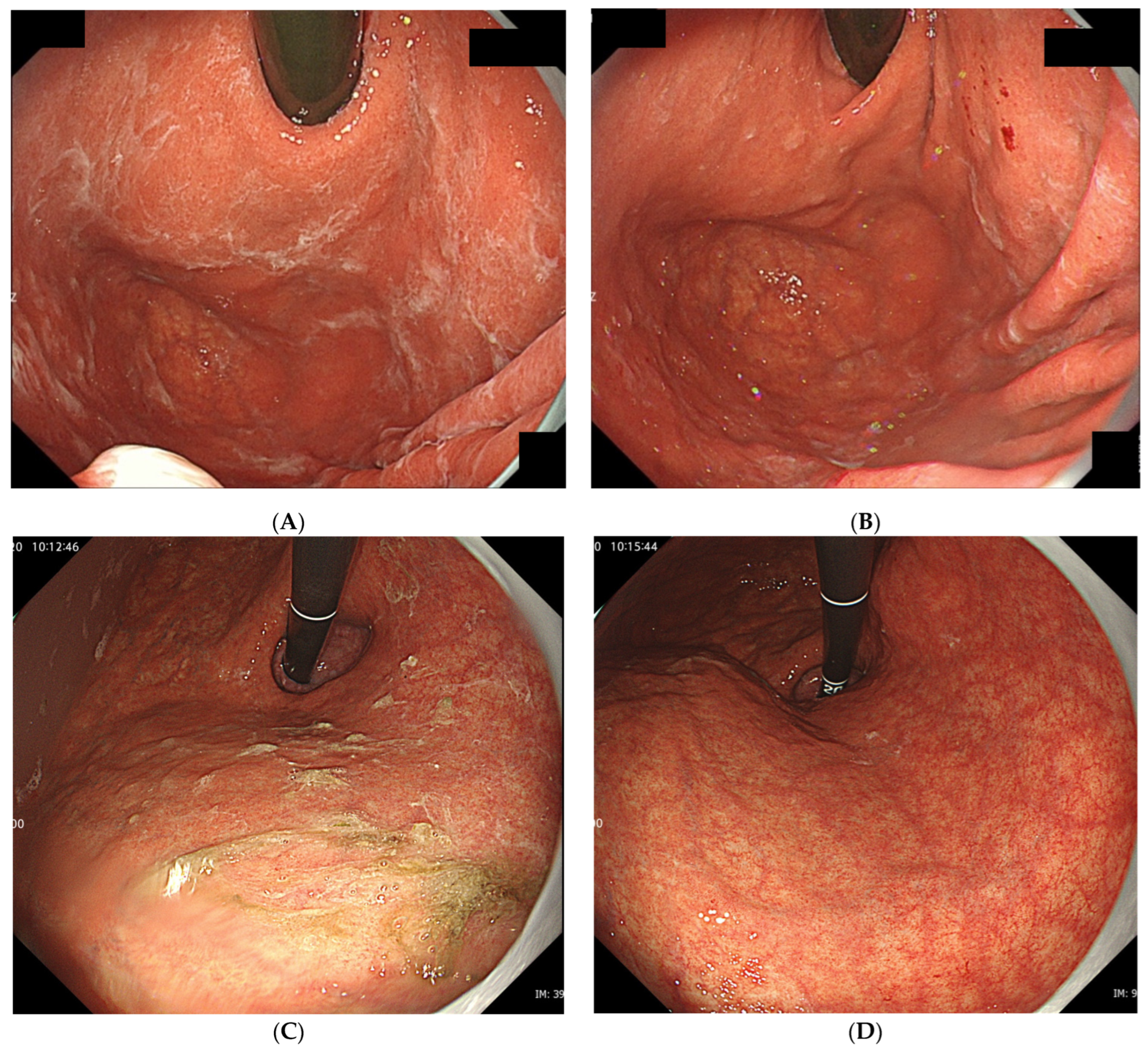
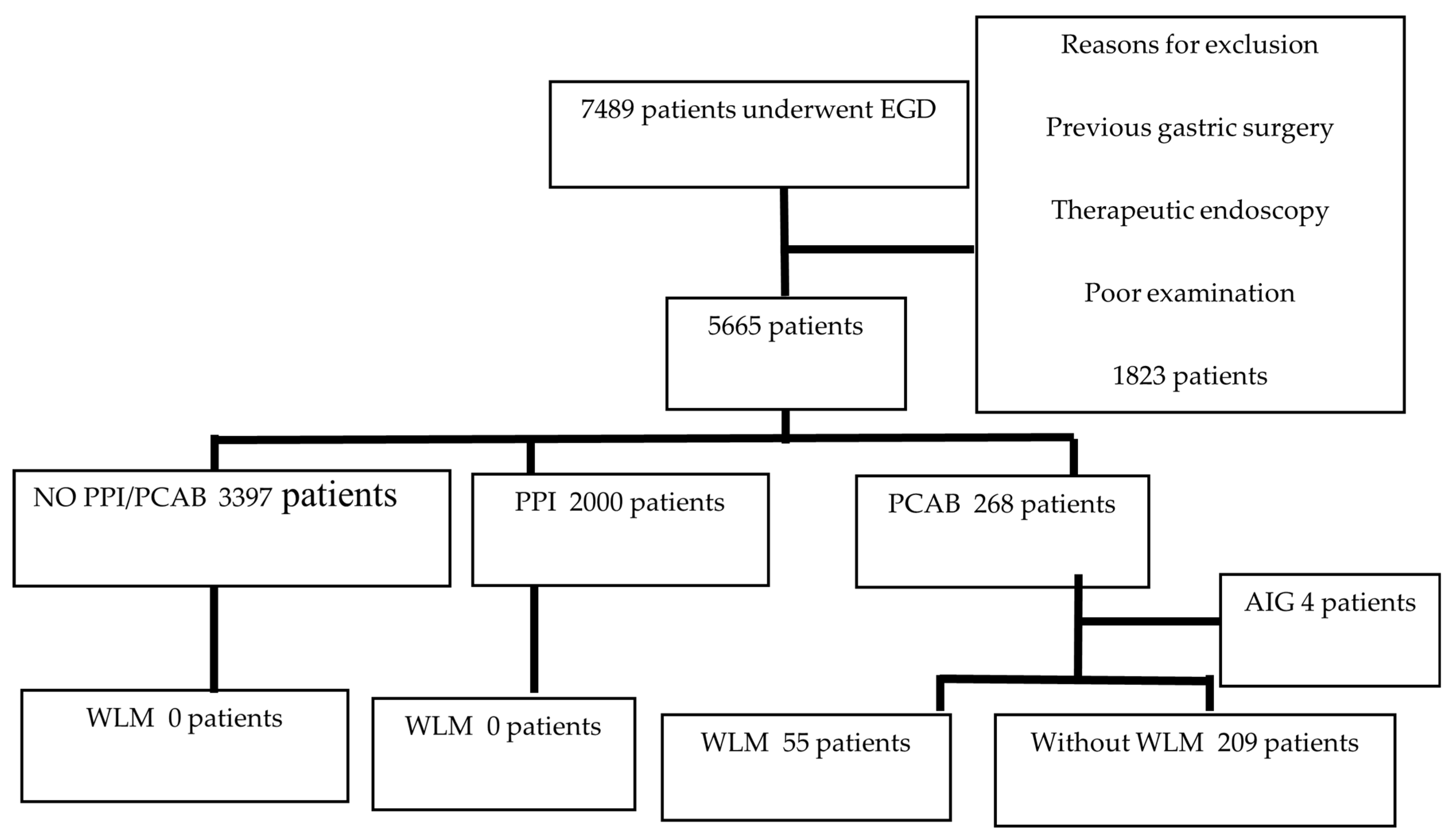
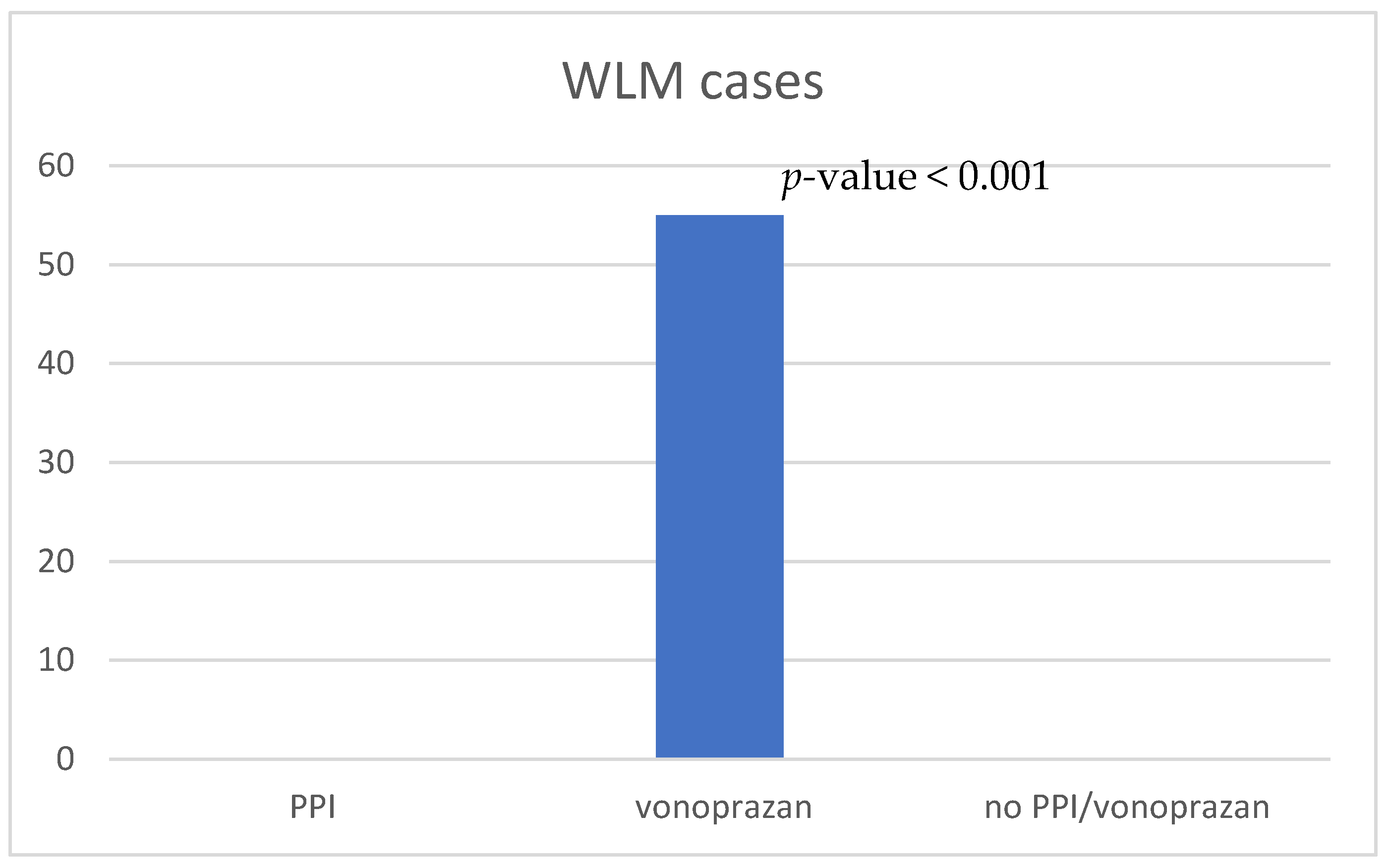
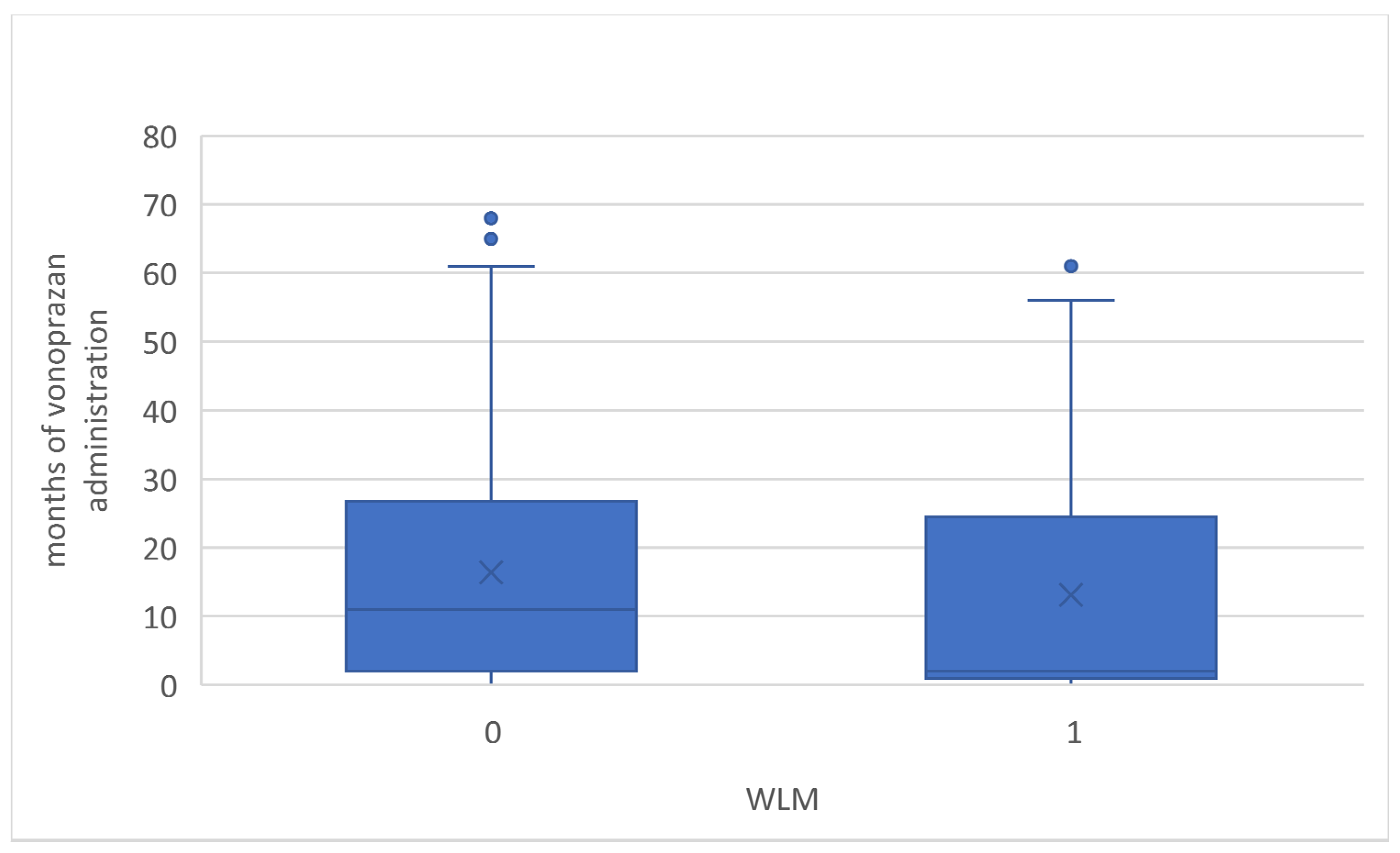
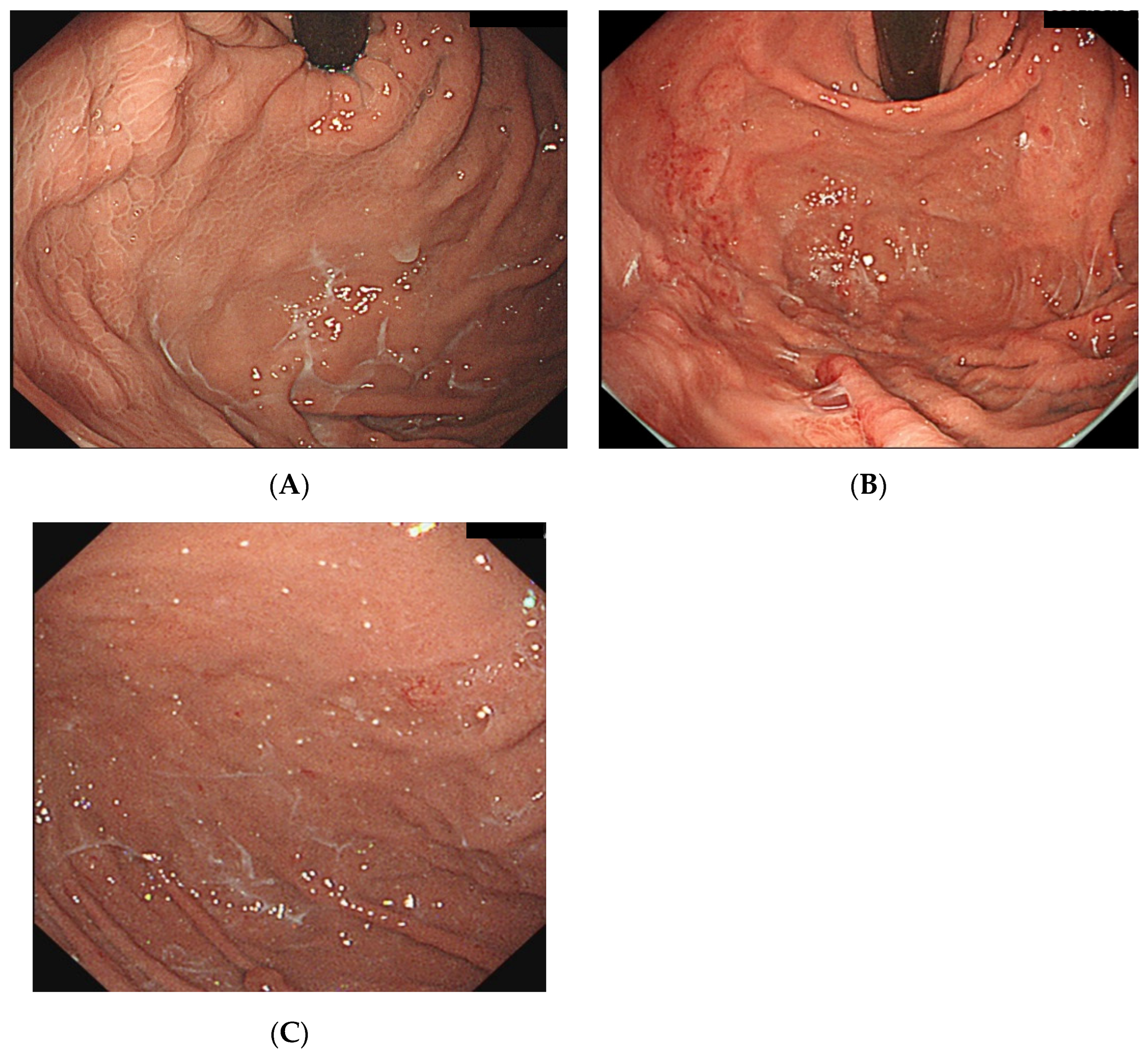
| WLM (n = 55) | Without WLM (n = 209) | p-Value | |
|---|---|---|---|
| Sex (M/F) | 28/27 | 112/97 | 0.763 |
| Age, mean ± SD (years) | 65.5 ± 11.5 | 65 ± 11.6 | 0.226 |
| CKD (%) | 3 (5%) | 18 (9%) | 0.582 |
| DM (%) | 9 (16%) | 39 (18%) | 0.845 |
| HP eradication (%) | 14 (25%) | 81 (39%) | 0.082 |
| Smoking (%) | 9 (16%) | 34 (16%) | 1.0 |
| Alcohol consumption (%) | 23 (42%) | 80 (38%) | 0.644 |
| Antibiotics (%) | 3 (5%) | 4 (2%) | 0.160 |
| Rebamipid (%) | 8 (14%) | 43 (20%) | 0.442 |
| Steroids or other immunosuppressive agents (%) | 6 (11%) | 14 (7%) | 0.388 |
| NSAIDs (%) | 3 (5%) | 8 (4%) | 0.703 |
| Antithrombotic drugs (%) | 15 (27%) | 41 (20%) | 0.196 |
| Median no. of months of vonoprazan administration (IQR) | 2 (1–24) | 11 (2–26) | 0.098 |
| OR | p-Value | 95% CI | |
|---|---|---|---|
| Male | 0.724 | 0.399 | 0.342–1.534 |
| Age | 0.976 | 0.058 | 0.951–1.001 |
| Antibiotics | 4.161 | 0.273 | 0.325–53.193 |
| Antithrombotic drugs | 1.968 | 0.118 | 0.841–4.602 |
| Duration of vonoprazan administration | 0.990 | 0.418 | 0.968–1.014 |
| WLM (n = 55) | No-WLM (n = 209) | p-Value | |
|---|---|---|---|
| Cobblestone gastric mucosa (%) | 24 (44%) | 92 (44%) | 1.00 |
| Gastric mucosal redness (%) | 12 (22%) | 36 (17%) | 0.436 |
| Atrophic gastritis (none/closed/open) | 34/13/8 | 57/88/64 | 0.264 |
| Multiple white and flat elevated lesions (%) | 3 (5%) | 13 (6%) | 1.00 |
| Stardust gastric mucosa/WGA (%) | 8 (15%) | 16 (8%) | 0.120 |
| Fundic gland polyps (%) | 18 (33%) | 44 (21%) | 0.076 |
| Hyperplastic polyps (%) | 4 (7%) | 24 (11%) | 0.466 |
Disclaimer/Publisher’s Note: The statements, opinions and data contained in all publications are solely those of the individual author(s) and contributor(s) and not of MDPI and/or the editor(s). MDPI and/or the editor(s) disclaim responsibility for any injury to people or property resulting from any ideas, methods, instructions or products referred to in the content. |
© 2024 by the authors. Licensee MDPI, Basel, Switzerland. This article is an open access article distributed under the terms and conditions of the Creative Commons Attribution (CC BY) license (https://creativecommons.org/licenses/by/4.0/).
Share and Cite
Kaneko, H.; Sato, H.; Suzuki, Y.; Ikeda, A.; Kuwashima, H.; Ikeda, R.; Sato, T.; Irie, K.; Sue, S.; Maeda, S. A Novel Characteristic Gastric Mucus Named “Web-like Mucus” Potentially Induced by Vonoprazan. J. Clin. Med. 2024, 13, 4070. https://doi.org/10.3390/jcm13144070
Kaneko H, Sato H, Suzuki Y, Ikeda A, Kuwashima H, Ikeda R, Sato T, Irie K, Sue S, Maeda S. A Novel Characteristic Gastric Mucus Named “Web-like Mucus” Potentially Induced by Vonoprazan. Journal of Clinical Medicine. 2024; 13(14):4070. https://doi.org/10.3390/jcm13144070
Chicago/Turabian StyleKaneko, Hiroaki, Hiroki Sato, Yuichi Suzuki, Aya Ikeda, Hirofumi Kuwashima, Ryosuke Ikeda, Takeshi Sato, Kuniyasu Irie, Soichiro Sue, and Shin Maeda. 2024. "A Novel Characteristic Gastric Mucus Named “Web-like Mucus” Potentially Induced by Vonoprazan" Journal of Clinical Medicine 13, no. 14: 4070. https://doi.org/10.3390/jcm13144070
APA StyleKaneko, H., Sato, H., Suzuki, Y., Ikeda, A., Kuwashima, H., Ikeda, R., Sato, T., Irie, K., Sue, S., & Maeda, S. (2024). A Novel Characteristic Gastric Mucus Named “Web-like Mucus” Potentially Induced by Vonoprazan. Journal of Clinical Medicine, 13(14), 4070. https://doi.org/10.3390/jcm13144070







